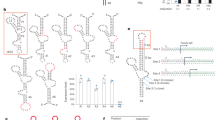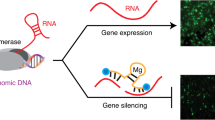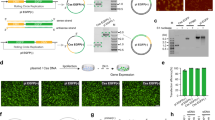Abstract
Numerous synthetic RNA-based controls for integrating sensing switches with function devices have been demonstrated in a variety of organisms for gene regulation. Although potential advantages of RNA-based genetic control strategies have been shown in clinical applications, successfully extending these engineered systems into medical applications has seldom been reported. Here, a synthetic RNA-based ribozyme system and its application in advancing rationally designed cellular therapy were described. The theophylline-responsive, ribozyme-based device provided a powerful platform for suicide gene expression regulation in tumor cells. Moreover, we demonstrate the ability of our synthetic controller to modulate effectively the viability of the cells in response to drug input. Our RNA-based regulatory system could dose-dependently fine-tune transgene expression in mammalian cells and address urgent limitations in existing genetic control strategies for gene- and cell-based therapies in the future.
This is a preview of subscription content, access via your institution
Access options
Subscribe to this journal
Receive 12 print issues and online access
$259.00 per year
only $21.58 per issue
Buy this article
- Purchase on Springer Link
- Instant access to full article PDF
Prices may be subject to local taxes which are calculated during checkout





Similar content being viewed by others
References
Moolten FL . Tumor chemosensitivity conferred by inserted herpes thymidine kinase genes: paradigm for a prospective cancer control strategy. Cancer Res 1986; 46: 5276–5281.
Fillat C, Carrio M, Cascante A, Sangro B . Suicide gene therapy mediated by the herpes simplex virus thymidine kinase gene/ganciclovi system: fifteen years of application. Curr Gene Ther 2003; 3: 13–26.
Shen Y, Nemunaitis J . Herpes simplex virus 1 (HSV-1) for cancer treatment. Cancer Gene Ther 2006; 13: 975–992.
Ardiani A, Sanchez-Bonilla M, Black ME . Fusion enzymes containing HSV-1 thymidine kinase mutants and guanylate kinase enhance prodrug sensitivity in vitro and in vivo. Cancer Gene Ther 2010; 17: 86–96.
Chatelut E, Delord JP, Canal P . Toxicity patterns of cytotoxic drugs. Invest New Drug 2003; 21: 141–148.
Peterson DE, Cariello A . Mucosal damage: a major risk factor for severe complications after cytotoxic therapy. Semin Oncol 2004; 31: 35–44.
Bleakley M, Riddell SR . Molecules and mechanisms of the graft-versus-leukaemia effect. Nat Rev Cancer 2004; 4: 371–380.
Yee C, Thompson JA, Roche P, Byrd DR, Lee PP, Piepkorn M et al. Melanocyte destruction after antigen-specific immunotherapy of melanoma: direct evidence of T cell-mediated vitiligo. J Exp Med 2000; 192: 1637–1643.
Horowitz MM, Gale RP, Sondel PM, Goldman JM, Kersey J, Kolb HJ et al. Graft-versus-leukemia reactions after bone marrow transplantation. Blood 1990; 75: 555–562.
Goulmy E . Human minor histocompatibility antigens: new concepts for marrow transplantation and adoptive immunotherapy. Immunol Rev 1997; 157: 125–140.
Kolb HJ, Schmid C, Barrett AJ, Schendel DJ . Graft-versus-leukemia reactions in allogeneic chimeras. Blood 2004; 103: 767–776.
Dudley ME, Wunderlich JR, Robbins PF, Yang JC, Hwu P, Schwartzentruber DJ et al. Cancer regression and autoimmunity in patients after clonalrepopulation with antitumor lymphocytes. Science 2002; 298: 850–854.
Traversari C, Marktel S, Magnani Z, Mangia P, Russo V, Ciceri F et al. The potential immunogenicity of the TK suicide gene does not prevent full clinical benefit associated with the use of TK-transduced donor lymphocytes in HSCT for hematologic malignancies. Blood 2007; 109: 4708–4715.
Ciceri F, Bonini C, Stanghellini MT, Bondanza A, Traversari C, Salomoni M et al. Infusion of suicide-gene-engineered donor lymphocytes after family haploidentical haemopoietic stem-cell transplantation for leukaemia (the TK007 trial): a non-randomised phase I–II study. Lancet Oncol 2009; 10: 489–500.
Burt RK, Drobyski WR, Seregina T, Traynor A, Oyama Y, Keever-Taylor C et al. Herpes simplex thymidine kinase gene–transduced donor lymphocyte infusions. Exp Hematol 2003; 31: 903–910.
Berger C, Flowers ME, Warren EH, Riddell SR . Analysis of transgene-specific immune responses that limit thein vivopersistence of adoptively transferred HSV-TK-modified donor T cells after allogeneic hematopoietic cell transplantation. Blood 2006; 107: 2294–2301.
Frank O, Rudolph C, Heberlein C, von Neuhoff N, Schrock E, Schambach A et al. Tumor cells escape suicide gene therapy by genetic and epigenetic instability. Blood 2004; 104: 3543–3549.
Greco R, Oliveira G, Stanghellini MT, Vago L, Bondanza A, Peccatori J et al. Improving the safety of cell therapy with the TK-suicide gene. Front Pharmacol 2015; 6: 1–13.
Na D, Yoo SM, Chung H, Park H, Park J H, Lee S Y et al. Metabolic engineering of Escherichia coli using synthetic small regulatory RNAs. Nat Biotechnol 2013; 31: 170–174.
Ruder WC, Lu T, Collins JJ . Synthetic biology moving into the clinic. Science 2011; 333: 1248–1252.
Chen X J, Li T, Wang X, Du Z, Liu R, Yang Y . Synthetic dual-input mammalian genetic circuits enable tunable and stringent transcription control by chemical and light. Nucleic Acids Res 2016; 44: 2677–2690.
Nudler E, Mironov A S . The riboswitch control of bacterial metabolism. Trends Biochem Sci 2004; 29: 11–17.
Lin S, Gao W, Tian Z, Yang C, Lu L, Mergny JL et al. Luminescence switch-on detection of protein tyrosine kinase-7 using a G-quadruplex-selective probe. Chem Sci 2015; 6: 4284–4290.
Leung KH, Zhang HH, He B, Zhong JH, Lin S, Wang YT et al. Label-free luminescence switch-on detection of hepatitis C virus NS3 helicase activity using a G-quadruplex-selective probe. Chem Sci 2015; 6: 2166–2171.
Beilstein K, Wittmann A, Grez M, Suess B . Conditional control of mammalian gene expression by tetracycline-dependent hammerhead ribozymes. ACS Synth Biol 2014; 4: 526–534.
Win MN, Smolk CD . A modular and extensible RNA-based gene-regulatory platform for engineering cellular function. Proc Natl Acad Sci USA 2007; 104: 14283–14288.
Ketzer P, Haas SF, Engelhardt S, Hartig JS, Nettelbeck DM . Synthetic riboswitches for external regulation of genes transferred by replication-deficient and oncolytic adenoviruses. Nucleic Acids Res 2012; 40: e167.
Nomura Y, Zhou L, Miu A, Yokobayashi Y . Controlling mammalian gene expression by allosteric hepatitis delta virus ribozymes. ACS Synth Biol 2013; 2: 684–689.
Chen YY, Jensen MC, Smolk CD . Genetic control of mammalian T-cell proliferation with synthetic RNA regulatory systems. Proc Natl Acad Sci USA 2010; 107: 8531–8536.
Marin V, Cribioli E, Philip B, Tettamanti S, Pizzitola I, Biondi A et al. Comparison of different suicide-gene strategies for the safety improvement of genetically manipulated T cells. Hum Gene Ther Methods 2012; 23: 376–386.
Wieland M, Auslander D, Fussenegger M . Engineering of ribozyme-based riboswitches for mammalian cells. Methods 2012; 56: 351–357.
Auslander S, Ketzer P, Hartig JS . A ligand-dependent hammerhead ribozyme switch for controlling mammalian gene expression. Mol Biosyst 2010; 6: 807–814.
Jenison RD, Gill SC, Pardi A, Polisky B . High-resolution molecular discrimination by RNA. Science 1994; 263: 1425–1429.
Wittmann A, Suess B . Selection of tetracycline inducible self-cleaving ribozymes as synthetic devices for gene regulation in yeast. Mol Biosyst 2011; 7: 2419–2427.
Geering B, Fussenegger M . Synthetic immunology: modulating the human immune system. Trends Biotechnol 2015; 33: 65–79.
Acknowledgements
This work was financially supported by the National Natural Science Foundation of China (31300096, 21275156), Natural Science Foundation of Jiangsu Province (BK20130351, BK20130357) and the CAS/SAFEA International Innovation Teams program.
Author information
Authors and Affiliations
Corresponding author
Ethics declarations
Competing interests
The authors declare no conflict of interest.
Rights and permissions
About this article
Cite this article
Zhang, Y., Wang, J., Cheng, H. et al. Conditional control of suicide gene expression in tumor cells with theophylline-responsive ribozyme. Gene Ther 24, 84–91 (2017). https://doi.org/10.1038/gt.2016.78
Received:
Revised:
Accepted:
Published:
Issue Date:
DOI: https://doi.org/10.1038/gt.2016.78
This article is cited by
-
Re-engineering 10–23 core DNA- and MNAzymes for applications at standard room temperature
Analytical and Bioanalytical Chemistry (2019)



